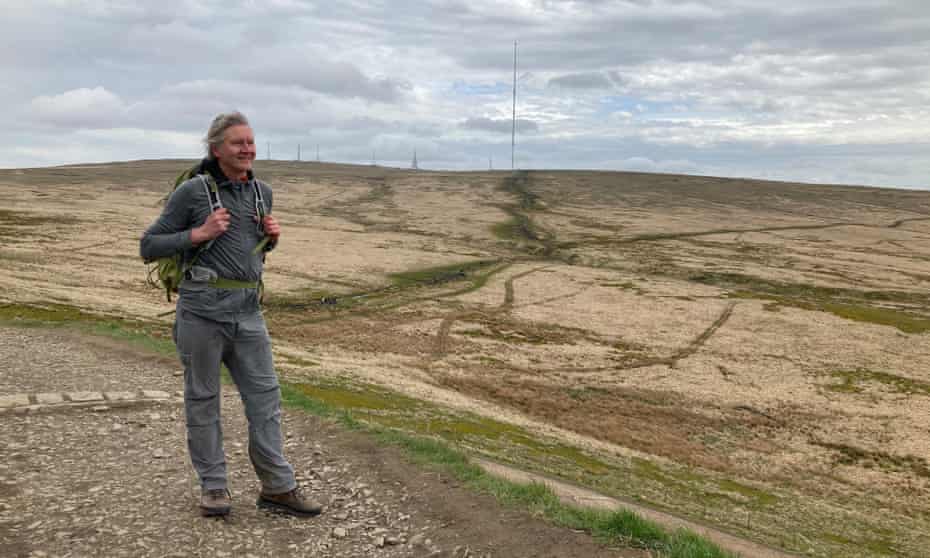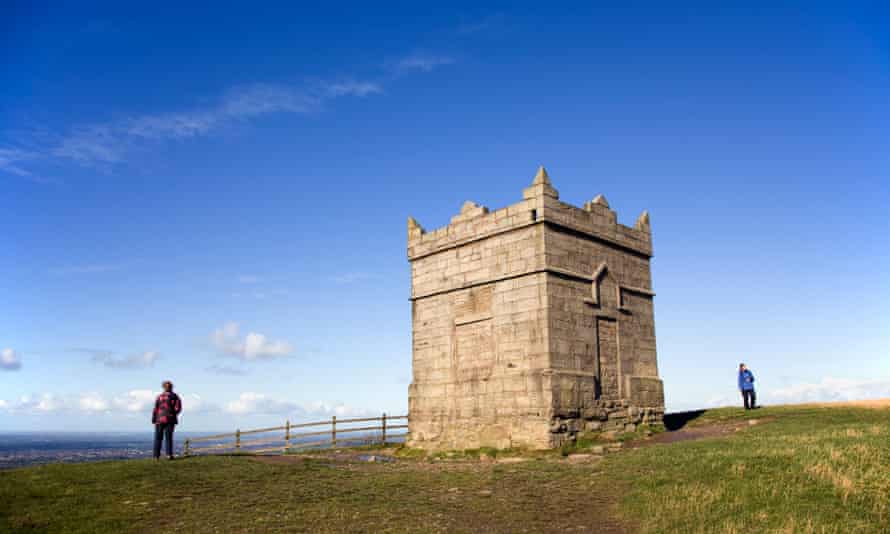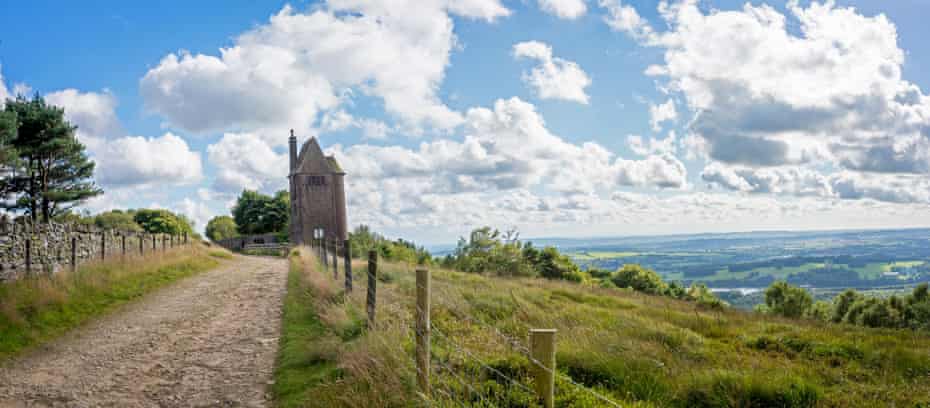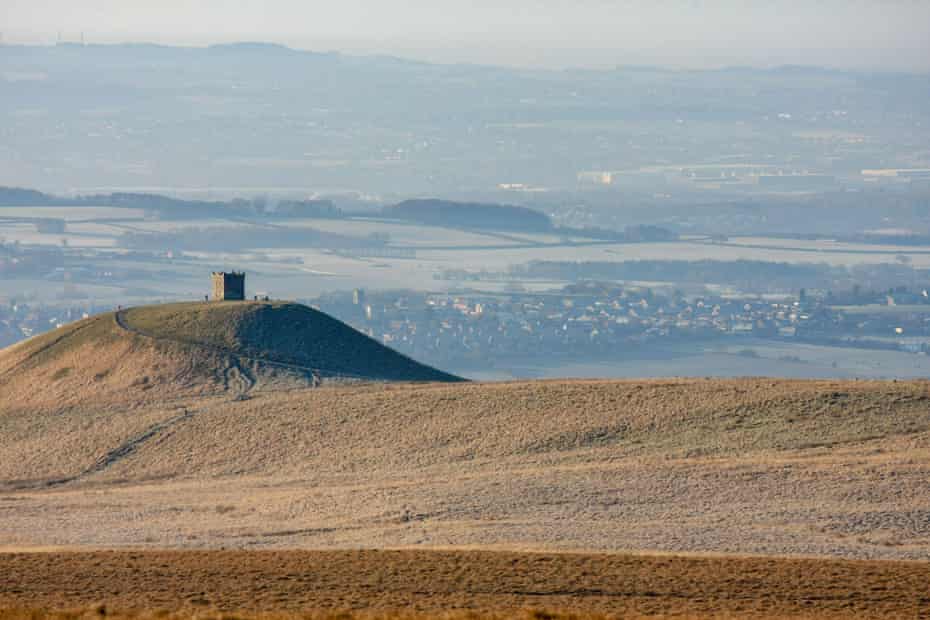Had the Devil been a Lancastrian he would have brought Jesus up Winter Hill and said, Worship me and whatever you see will be yours.
Because the view is truly extraordinary and spans much of the northwest, from the expanse of the flat coastal plain to the landmarks on its farthest edges, including Blackpool Tower, Fiddlers Ferry Power Station, Liverpool Docks and the Ribble Estuary. Below is the Bolton Wanderers’ stadium, the pride and joy of the city that the government told us in late May that it was a no-go and no-exit – advice that was later withdrawn.
I went on Saturday just before the “ban”. The hill was teeming with hikers, runners, cyclists and families drinking coffee and cake in the cafes around the mountain. Yet for all of Winter Hill’s sublime grandeur and local significance, it is a place most vacationers see from the M6 as they travel to the lakes and valleys or down to North Wales and beyond. I know I grew up staring at it in my bedroom in South Lancashire and my parents never thought of taking me in. It wasn’t “great nature” – it was just a barren moor and a television pole, somewhere north of Manchester.
Still, it was exotic to my childhood eyes. In winter it had a frosty coat. In summer it got hazy and remote and sometimes disappeared entirely. In bad weather it looked terrifying, the needle on the summit poking up angry clouds and causing them to rain, hail, thunder and lightning to punish the people of the Pennines. Yes Pennines, because although the hill has a semi-suburban aspect due to its proximity to Blackburn, Bolton and Chorley, it is part of the West Pennine Moors and is connected to the main Pennine Way by a volunteer-led footpath.
 The writer on Winter Hill with its many communication masts.
The writer on Winter Hill with its many communication masts.
I took a well-marked zigzag uphill path and followed a partially boarded footpath over a peat bog, passing a group of young people fighting with maps at an awards ceremony for the Duke of Edinburgh. This led me to the base of the television mast, which is now flanked by cell towers. It’s a wide, exposed peak, and the only place I could have a cup of coffee was next to one of the huge metal pegs that the guys who supported the mast were tied to. It was windy, but the early summer sun was shining and larks could be heard above the whistling of the steel cables.
Just as most motorists ignore Winter Hill, so many hikers miss the glorious history of their recreation area
We Lancastrians of the pre-digital age gave the mast a sense of belonging. In addition to living in the county, we lived in the television district of Granada. If Coronation Street was on, or the news or World in Action, you knew they were beamed from Winter Hill. It was light in the dark (especially during the many blackouts of my childhood); artificial sunshine in the long winters.
This is exactly what the socialist entrepreneur Sidney Bernstein, founder of Granada TV and builder of the mast, would have wished for.
“The north is a tightly knit indigenous industrial society,” he said. “A homogeneous cultural group with a good track record in music, theater, literature and newspapers that you won’t find anywhere else on this island, except maybe in Scotland.” With a wry smile, he added, “And of course if you get a map If you look at the population concentration in the north and a precipitation map, you will see that the north is an ideal place for television. “
 Rivington pike tower. Photo: Alamy
Rivington pike tower. Photo: Alamy
The mast is only slightly higher than three older landmarks. Most walkers can catch their breath at the Grade I listed Rivington Pike Tower, built in 1733 on the site of an older beacon used as a hunting lodge. Another focal point, a little further down, is the Pigeon Tower – built by William Hesketh Lever (aka Lord Leverhulme) as a birthday present to his wife Ellen. The tower and the terraced gardens it overlooks were part of Lever’s private property, which was laid out by Thomas Mawson between 1905 and 1925.
The third landmark, the Two Lads Cairn, is a pile of stones on Crooked Edge Hill that is large enough to resemble a tower from certain angles. Conflicting legends say that the boys were two Saxon princes, two sons of a bishop or two children who worked in a mill.
If the peaks of our more celebrated peaks have a generally bourgeois atmosphere – the tech gear, the smart devices, the “hydration” beverages – the top of Winter Hill felt commonplace, intergenerational, multi-ethnic, and communal. This was particularly fitting given the hill’s role in our nation’s vast history.
 Pigeon Tower, which was built by William Hesketh Lever (aka Lord Leverhulme). Photo: Ruaux / Alamy
Pigeon Tower, which was built by William Hesketh Lever (aka Lord Leverhulme). Photo: Ruaux / Alamy
In August 1896, Colonel Richard Henry Ainsworth, scion of a wealthy family who had made their fortune in the bleaching trade and resident of Smithills Hall, decided to close a well-traveled road that crossed his land on the southeastern slope of Winter Hill. His company’s dependence on the hill’s watercourses may have given him an ownership perspective. He also viewed walkers – whether they were trudging to work or going up there after a week of work in a factory, mine, or mill to get some clean air – as unwanted intruders into the land he used to hunt grouse. He had his rangers turn people back and build a gate on Coalpit Road to show that the path was closed.
There was hand-to-hand combat, but the colonel’s private army was no match for the mass of demonstrators
The locals were outraged by Ainsworth’s decision. The shoemaker Joe Shufflebotham, secretary of the Bolton Social Democratic Foundation, announced a march on the controversial path supported by the journalist and liberal radical Solomon Partington. On Sunday, September 6, 1896, about 10,000 people joined the march which led up Halliwell Road through a densely populated working-class neighborhood and up the mountain trail. A handful of police officers and rangers were waiting for them at the new gate. A hand-to-hand combat ensued, but the colonel’s private army was no match for the large number of demonstrators; the gate was smashed and the procession continued. When the victorious company reached their destination, Belmont, on the north side of Winter Hill, they drank up the inns.
The Bolton Journal reported that “the crowd far exceeded what was expected … the street was literally a sea of faces and the crowd included thousands of people of all ages and descriptions”. During that violent September there were three weekend marches and one on a Wednesday, the only day shop workers could attend. There was another march on Christmas Day.
Despite the numerical success of the popular uprising, Ainsworth had lawsuits against Shufflebotham, Partington, and others. The marches were halted while the case was being heard in court. The colonel won and left the protesters to pay the costs. The end of the process was long: although locals were able to use the path from the 1930s, public access was not officially secured until 1996.
The mass march (the walkers would not have called it a “transgression”) of 1896 never received as much attention as the 1932 March on the Kinder Scout, led by Manchester Communist Benny Rothman, who is usually credited with leading to the Creation of the British National Parks.
“Although the march was a massive event, it was very local and only included people living within two or three miles,” says Bolton-based historian and author Paul Salveson, an expert on the Winter Hill events. “That, and the fact that they lost the case, could explain why it is not better known, although it has created greater awareness of rights of way in the Bolton area. World War I resulted in the slaughter of many participants and raised the curtain on so many working class activities. When I met Benny [Rothman] For Kinder Scout’s 50th anniversary in 1982, he had never heard of Winter Hill. “
 Views of the countryside around Rivington Pike. Photo: Alamy
Views of the countryside around Rivington Pike. Photo: Alamy
Paul wrote a book about the march and was involved in commissioning a play for the first memorial service in 1982. His most recent publication, Moorlands, Memories and Reflections, celebrates writing in the country by dialect author and radical thinker Allen Clarke, who spoke about the march and wrote the rousing song about the Winter Hill protest, Will Yo ‘Come O’ Sunday Mornin ‘?
A memorial stone for the protesters stands on Coalpit Lane. But if that’s not what you’re looking for, you could walk around for miles without seeing any record of the historical collision. Just as most motorists ignore Winter Hill, so many hikers miss the glorious history of their recreation area.
This year – the 125th anniversary of the march – something could finally change. The Bolton Socialist Club, the Ramblers, the Woodland Trust, the housing association’s charity Bolton at Home and other community organizations and unions have joined forces for a memorial march along the original route for the weekend of September 6th. The folk singer Johnny Campbell released a single for the occasion. There is even talk of a new memorial to be built by a local quarry company.
“The events of 1896 showed how important the country was to the working class in the north,” says Salveson. “It still is. This year’s celebration of those momentous events 125 years ago is not just a reminder of Britain’s greatest rights of way demonstration of all time. It is meant to be a rally call that the landscape is still threatened, rights of way eroded and inappropriate developments are happening Threaten the landscape. “
Take part in the 125th anniversary events on Facebook



